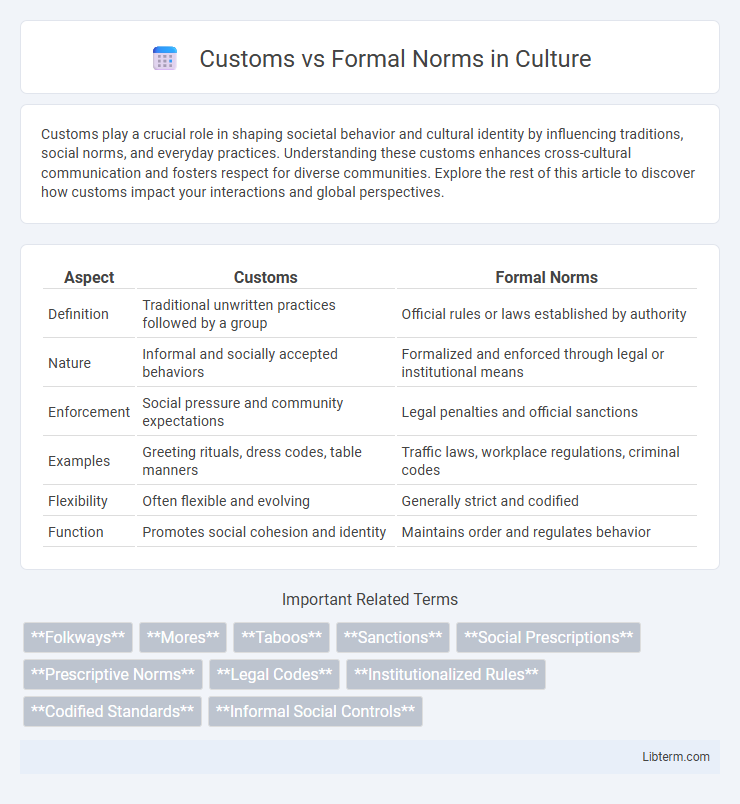Customs play a crucial role in shaping societal behavior and cultural identity by influencing traditions, social norms, and everyday practices. Understanding these customs enhances cross-cultural communication and fosters respect for diverse communities. Explore the rest of this article to discover how customs impact your interactions and global perspectives.
Table of Comparison
| Aspect | Customs | Formal Norms |
|---|---|---|
| Definition | Traditional unwritten practices followed by a group | Official rules or laws established by authority |
| Nature | Informal and socially accepted behaviors | Formalized and enforced through legal or institutional means |
| Enforcement | Social pressure and community expectations | Legal penalties and official sanctions |
| Examples | Greeting rituals, dress codes, table manners | Traffic laws, workplace regulations, criminal codes |
| Flexibility | Often flexible and evolving | Generally strict and codified |
| Function | Promotes social cohesion and identity | Maintains order and regulates behavior |
Understanding Customs and Formal Norms
Customs are traditional practices and social behaviors passed down through generations, shaping everyday interactions within a community without written enforcement. Formal norms, such as laws and regulations, are codified standards established by official institutions to regulate conduct with clear consequences for violations. Understanding the distinction enhances social cohesion by recognizing informal cultural expectations alongside legally binding rules.
Defining Customs: Social Practices Explained
Customs are traditional social practices that develop naturally within communities, reflecting shared values and collective behaviors passed down through generations. These informal norms guide everyday interactions and rituals without formal enforcement mechanisms, contrasting with formal norms like laws or regulations that carry official sanctions. Understanding customs highlights how cultural continuity shapes social cohesion through habitual, accepted ways of acting in specific contexts.
What Are Formal Norms? Key Characteristics
Formal norms are established rules or laws enacted by official institutions to regulate behavior within a society. Key characteristics include codification in legal documents, enforceability through sanctions or penalties, and clear definitions that outline acceptable and unacceptable actions. These norms ensure order and predictability by providing standardized guidelines that individuals and organizations are legally obligated to follow.
Origins and Evolution of Customs
Customs originate from long-established social practices rooted in collective experiences and cultural traditions that guide everyday behavior without formal regulation. Over time, these informal norms evolve through continuous social interaction, adapting to changing values and societal needs while maintaining their foundational role in community cohesion. Unlike formal norms codified by legal systems or institutions, customs develop organically and serve as unwritten rules that shape identity and social order.
Legal Framework: How Formal Norms Are Enforced
Formal norms are enforced through established legal frameworks, including statutes, regulations, and judicial decisions that provide clear rules and penalties for non-compliance. Enforcement agencies such as police, courts, and regulatory bodies ensure adherence by monitoring behavior, investigating violations, and imposing sanctions like fines, imprisonment, or corrective orders. Unlike customs, which rely on social acceptance and informal sanctions, formal norms demand official mechanisms for their validation and implementation within society.
Examples of Customs in Different Cultures
Traditional customs such as Japan's tea ceremony exemplify formalized social practices reflecting respect and harmony, while India's Diwali festival showcases cultural rituals emphasizing light and prosperity. In Mexico, the Day of the Dead custom involves honoring ancestors through altar offerings, combining indigenous beliefs with Catholic elements. These customs demonstrate how cultural norms vary globally, embedding values and social cohesion within distinct communities.
Differences Between Customs and Formal Norms
Customs are informal social practices rooted in tradition and cultural habits, whereas formal norms are officially codified rules enforced by institutions and authorities. Customs guide everyday behavior through social expectations without legal penalties, while formal norms impose explicit sanctions for non-compliance. The flexibility of customs contrasts with the rigidity and clear consequences associated with formal norms in societal regulation.
The Role of Customs in Social Cohesion
Customs serve as enduring social practices that reinforce group identity and foster a sense of belonging, thereby enhancing social cohesion. By guiding behavior through shared expectations and informal rules, customs create predictability and trust among community members. Unlike formal norms enforced by laws or regulations, customs evolve organically and contribute to social harmony through cultural continuity.
Violations: Consequences of Breaking Norms
Violations of customs often result in social disapproval, exclusion, or informal sanctions within communities, reflecting the unwritten, culturally embedded nature of these norms. Breaking formal norms, codified in laws or regulations, triggers legal consequences such as fines, imprisonment, or other judicial penalties enforced by governmental authorities. Understanding the distinction between informal social sanctions for customs and formal legal repercussions for formal norms is crucial for navigating societal expectations and maintaining social order.
Customs and Formal Norms: Impact on Society
Customs shape societal behavior through unwritten, traditional practices that foster social cohesion and continuity over generations. Formal norms, codified as laws or regulations, establish clear expectations and consequences, ensuring order and fairness within communities. Together, customs and formal norms influence social stability by balancing flexibility with enforceable standards in everyday interactions.
Customs Infographic

 libterm.com
libterm.com